The Driving and Opposing Forces of the Machine Economy
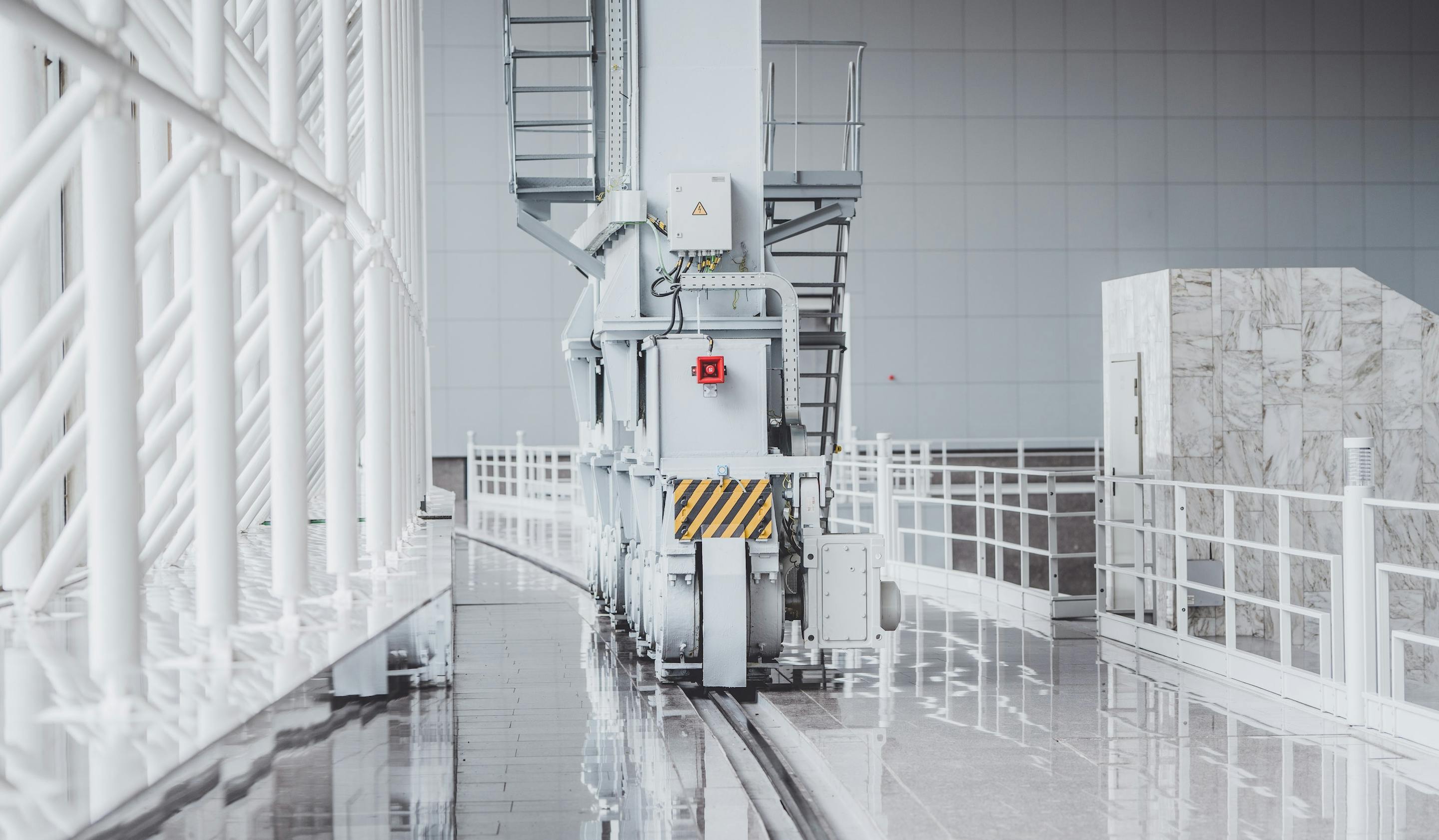
Companies across the globe are tackling some of the greatest challenges since their inception as they attempt to figure out how best to protect and secure their market share amidst current — and potential future — economic uncertainties.
Although today’s business environment is marked by significant change, it’s also recognized for its emerging technology trends, its considerable market opportunities, and its innovation strategies as a result of rising competition.
As the business technology market nears $4 trillion in annual spending, technology vendors and service providers are assessing the market to expand into new geographies and grow their business. New technologies are impacting all industries, but perhaps none more than the manufacturing sector. Due to the increasing commoditization of machines, more companies are developing in the direction of software and services. The potential for organizations to earn profits by offering services on top of their existing products has moved far beyond B2C to include B2B agreements.
This type of business offering has become known as the ‘as-a-service’ business model which delivers the desired result instead of needing to own the equipment that delivers that result. The ‘as-a-service’ trend has emerged as a response to the demands made by technology consumers for greater levels of innovation through product infrastructure, software, and service upgrades. Business leaders are shifting their mindsets from product-focused innovation to process-focused innovation, which has more commonly become known as business model innovation (BMI).
When companies offer additional services on top of their original offering, it can play the role of both an offensive and a defensive business strategy. Around 59% of executives view servitization as a proactive approach to grow revenues and profits while 30% of executives view servitization as a way to keep existing customers and build barriers to competitor entry.
The ‘as-a-service’ business model is a key enabler of the Machine Economy. Remaining ahead of the curve in adopting modern consumption models is crucial for business leaders to maintain a competitive edge in the global developing digital landscape.
The Foundation of the Machine Economy
Large enterprises generally adopt emerging technologies up to 10 times faster than small businesses and tend to place greater priority on IoT since they typically have more resources than small-to-medium-sized enterprises (SMEs). The manufacturing industry, which is known for its high resource intensity and modern equipment requirements, will be the sector that stands to benefit the most from implementing networked machinery and intelligent systems. Manufacturing companies are moving away from a ‘make and sell’ business model to instead focus on a model that increasingly adopts and embraces services.
Apart from its core technologies —IoT, AI, and DLT— the Machine Economy is made up of three additional quintessential parts: machines, software, and services.
1. Machines
Competition in the market is fierce which means that high-quality machines are already becoming less of a unique selling point in many areas. This is increasing the pressure for premium manufacturers to create offerings that differentiate from their competitors which is most often in machine capabilities (automation, responsiveness, analysis, etc.), and pricing structures.
2. Software
Software is arguably the most important aspect of these three components —the glue — that ties together the machine and service layers. Today, the software is primarily used for adding individualized features to machines. It also offers a solution to establish long-term business relationships with customers over the lifecycle of a product with the provision of extensive customer support and the option to add more features to the existing product.
3. Services
In addition to software components, data services are becoming more important. Machine operators are increasingly open to a complete solution from manufacturers, resulting in a growing number of service-oriented business models. As data becomes an increasingly valuable resource and a key enabler of the ‘as-a-service’ model, businesses are investing more into machinery that can perform tasks such as predictive analysis, root cause analysis, remote monitoring, autonomous transactions, and more.
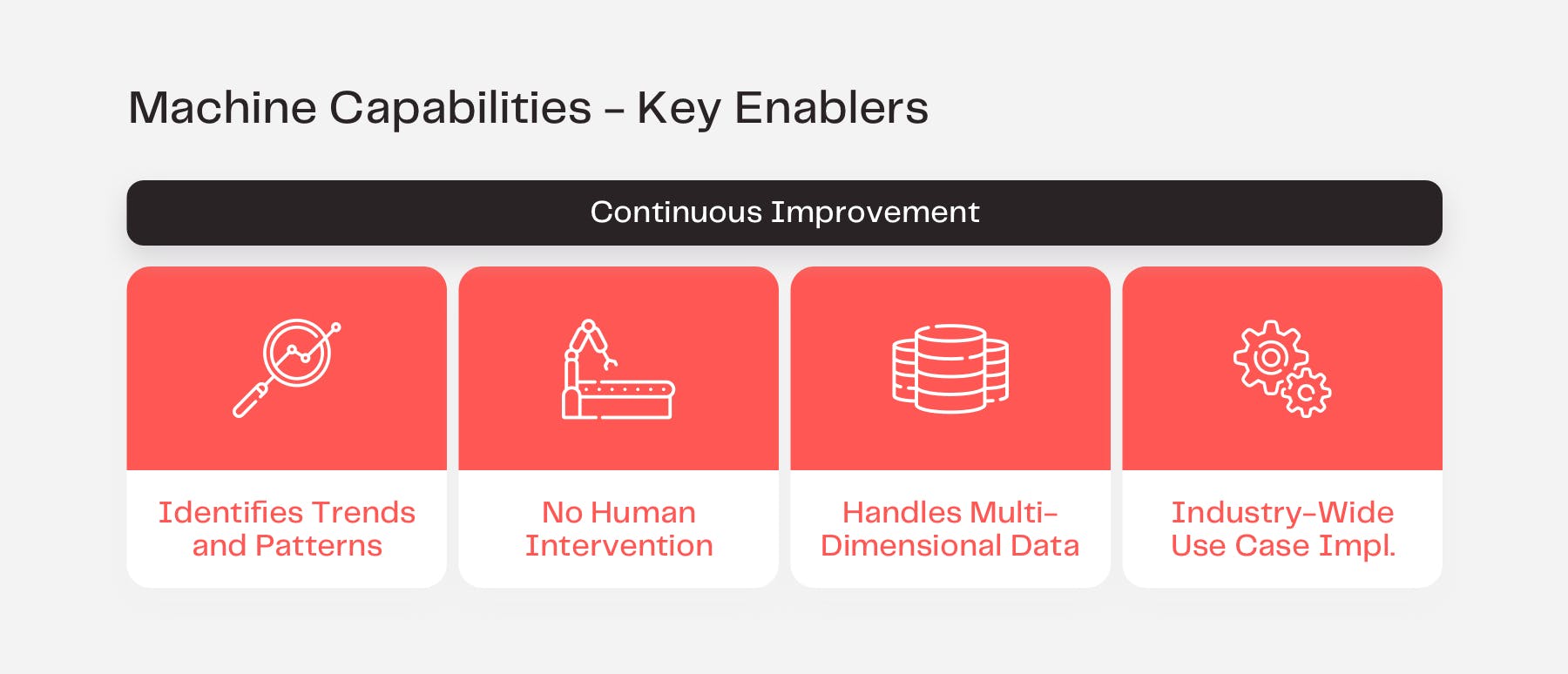
Integrating machines with software and service capabilities are just the beginning of what’s possible in a truly interconnected world, a future that isn’t that far off when the inevitable wide adoption of the Machine Economy takes place.
The Driving Forces of the Machine Economy
Understanding the driving forces and counterforces of the Machine Economy will allow business leaders to fully prepare for, and take advantage of, future market opportunities.
Several factors from the corporate environment have a direct and indirect positive influence on the development of the Machine Economy. Above all, external pressure is driving companies to explore new technologies and business solutions.
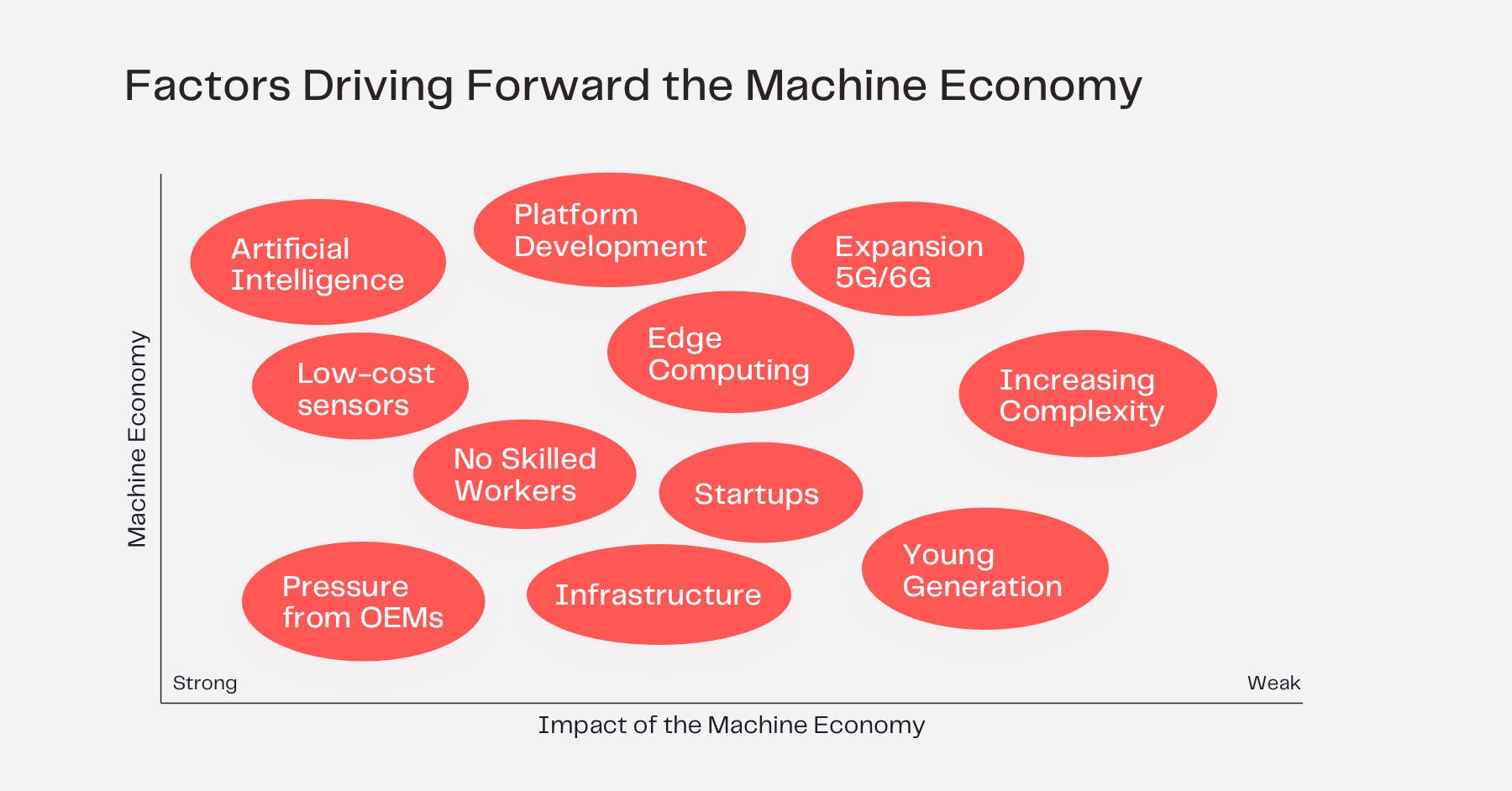
On an Economic Level
Each global jurisdiction has primary laws and regulatory requirements in place for the prevailing infrastructure of the country under consideration. This means that organizations must adhere to regional policies when exploring new technologies.
Increasing competition from other countries and global behemoths — namely the USA and Asia — puts companies under intense cost and innovation pressure. For many organizations, digital transformation strategies are directly linked to their self-preservation and leapfrogging efforts. Economic drivers of the Machine Economy include increasing competition, pressure from customers and partners, and a shift in company mindset. Businesses are determined to add new levels of servitization to extend the longevity of the end-user interaction. Solutions such as remote monitoring, predictive maintenance, and pay-per-use models play a major role here.
On a Socio-Economic Level
Well-known situations like the ‘brain drain’ and emigration often lead to the pronounced lack of skilled workers in many countries. It’s becoming increasingly difficult to find qualified personnel and as a result, companies are exploring new ways to simplify and automate processes. This has fueled many organizations to invest in autonomous machinery.
Alongside the just-in-time availability of production, usability and digital self-service are becoming more important. Younger generations and startups are considered among the top essential drivers for the development of the Machine Economy. The rapid adaptation and development of new technologies and generational product development are very often driven by young people.
On top of this, companies are facing increased pressure from customers. Customers will actively approach the companies themselves when they view those organizations as pioneers in the field of advanced technological development. In the Machine Economy, customers are increasingly becoming process designers. Their dynamic needs influence the capabilities of machines and shape future business models. As the needs of consumers change, businesses are working toward complete customer centrality to meet their demands and adhere to sustainable and efficient business processes.
On a Technological Level
Technological drivers include access to cheap sensor technology, its increasing capabilities, and the organizational appeal of edge computing, and AI. Industry standards are necessary to enable smooth communication between machines, humans, and entire organizations. This communication is a prerequisite for IoT solutions to spread widely since individual solutions can only be used to a limited extent for the supply chain.
Within industrial ecosystems, original equipment manufacturers (OEMs) are particularly influential in terms of digital adoption. Through their influence, suppliers are often required to investigate and implement new technology-centered projects and establish new standards that align with current digitalization expectations. As a result, the general increase in business complexity demands new solutions which lead to the creation of new business models such as pay-per-use models in the context of machines.
On a Partnership Level
Many early-stage companies have limited resources and often find it challenging to successfully launch technological developments. As a solution, strategic partnerships can promote the application of use cases by pooling together organizational resources and expertise. Startups are often among the leaders in disruptive tech adoption and are increasingly developing inexpensive IoT devices and sensors that can be attached to machines (retrofitting), thus enabling other companies to develop further in the area of the Machine Economy.
The Counterforces of the Machine Economy
As with any new technological era, the pace of adoption varies and depends on its demonstrable benefits which will lead to its arrival and widespread adoption.
On a Corporate Level
From the corporate environment, a number of factors have an inhibiting effect on the development of the Machine Economy. Counterforces at the economic level are above all the cost-intensive assumptions of IoT projects and the lack of skills to realize its implementation. Many companies find it difficult to identify concrete benefits or are simply trapped in outdated mindsets and business structures.
On a Legislative Level
A significant political counterforce is the unclear legal situation in many countries, especially relating to the exchange of data with other companies. This mainly concerns questions of data protection and the data sovereignty of collected data. Often, these uncertainties slow down the application and development of technologies, which in turn has a direct effect on the development of the Machine Economy.
On a Technology Stack Level
Technological counterforces include a lack of standards, hardware, and in many industries, a low level of development in companies. Today, the various components of IoT are often not compatible with each other in terms of hardware and software. The data output of different IoT devices and sensors is not standardized which means that the collected data often has to be readjusted before processing. This also makes it difficult to connect the machines to higher-level systems such as IoT platforms. As a result, it’s becoming even more important to increase the general compatibility of different hardware and software components and homogenize data outputs, interfaces, and APIs.
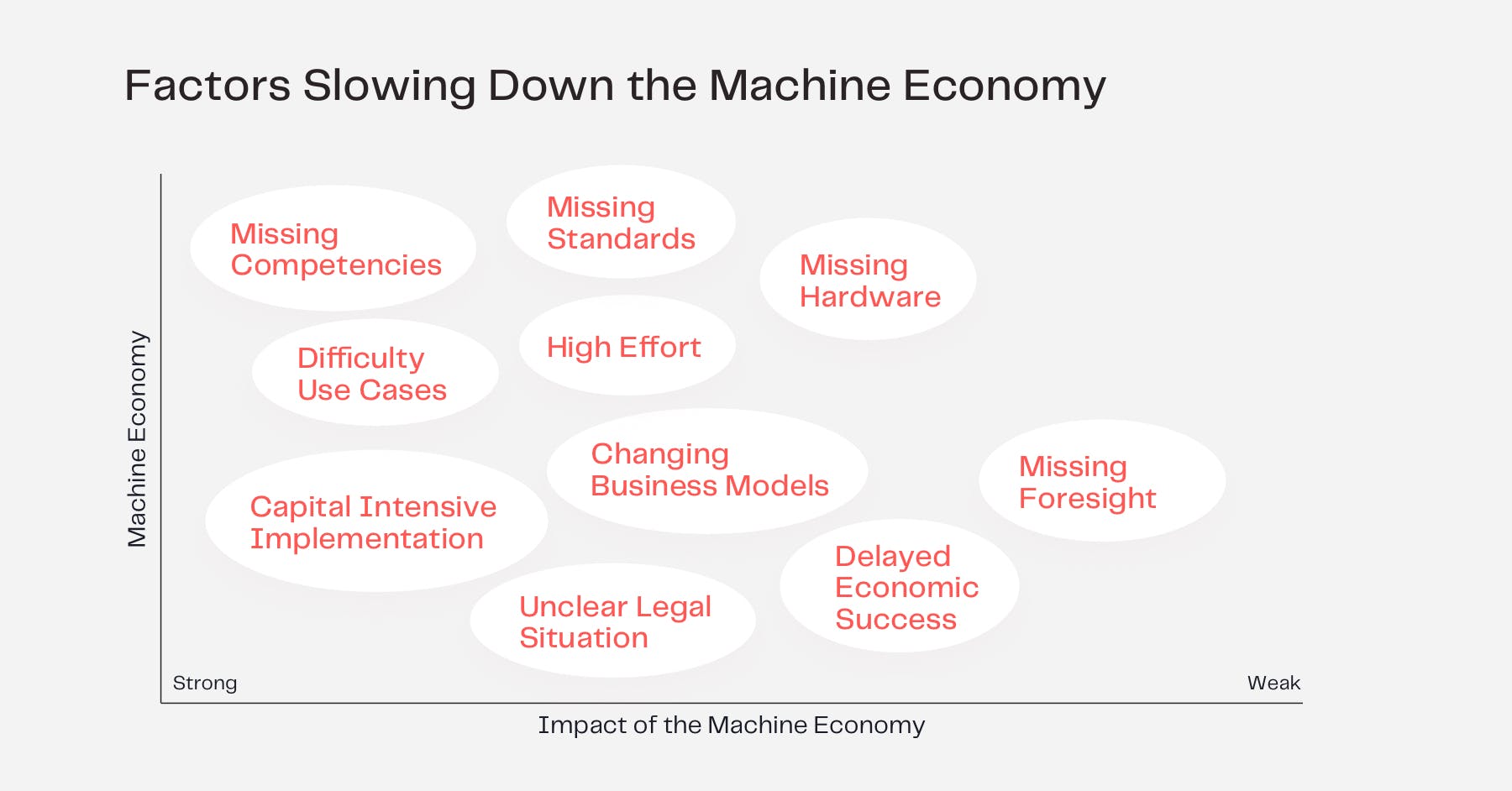
Businesses that are slow to adopt new technologies and consumption-based models are those that have difficulty in identifying the right solution for their specific needs or are unable to quantify the business problem that they’re aiming to solve.
While significant hurdles to the Machine Economy do exist, its immense potential for enhanced automation and value creation far exceeds its challenges.
Overcoming Business Challenges for an Automated Future
The most important consideration when investigating — and investing in — Machine Economy enablers is to:
1. Determine the business need
- How does this affect the ease of use for end-users?
2. Research the best solutions for your business
- What is the ease of use and how easy is it to deploy?
3. Vendor due diligence
- What is the cost of ownership and where does responsibility lie?
The most important step in overcoming the counterforces prohibiting technology adoption is for businesses to align specific technologies to each business strategy. Once the strategy is mapped out and in place, monitor its performance, and analyze this data extensively. If anomalies occur or business outcomes change; course correct in real-time.
Implementing new technology need not be overwhelmingly expensive. A better understanding of how a complex business works will lead to the prevention of bottlenecks in current processes. Performing a current system analysis and reviewing it thoroughly is the best way to deploy something new. For example, a popular solution in manufacturing is to retrofit existing systems with new technologies instead of buying entirely new equipment.
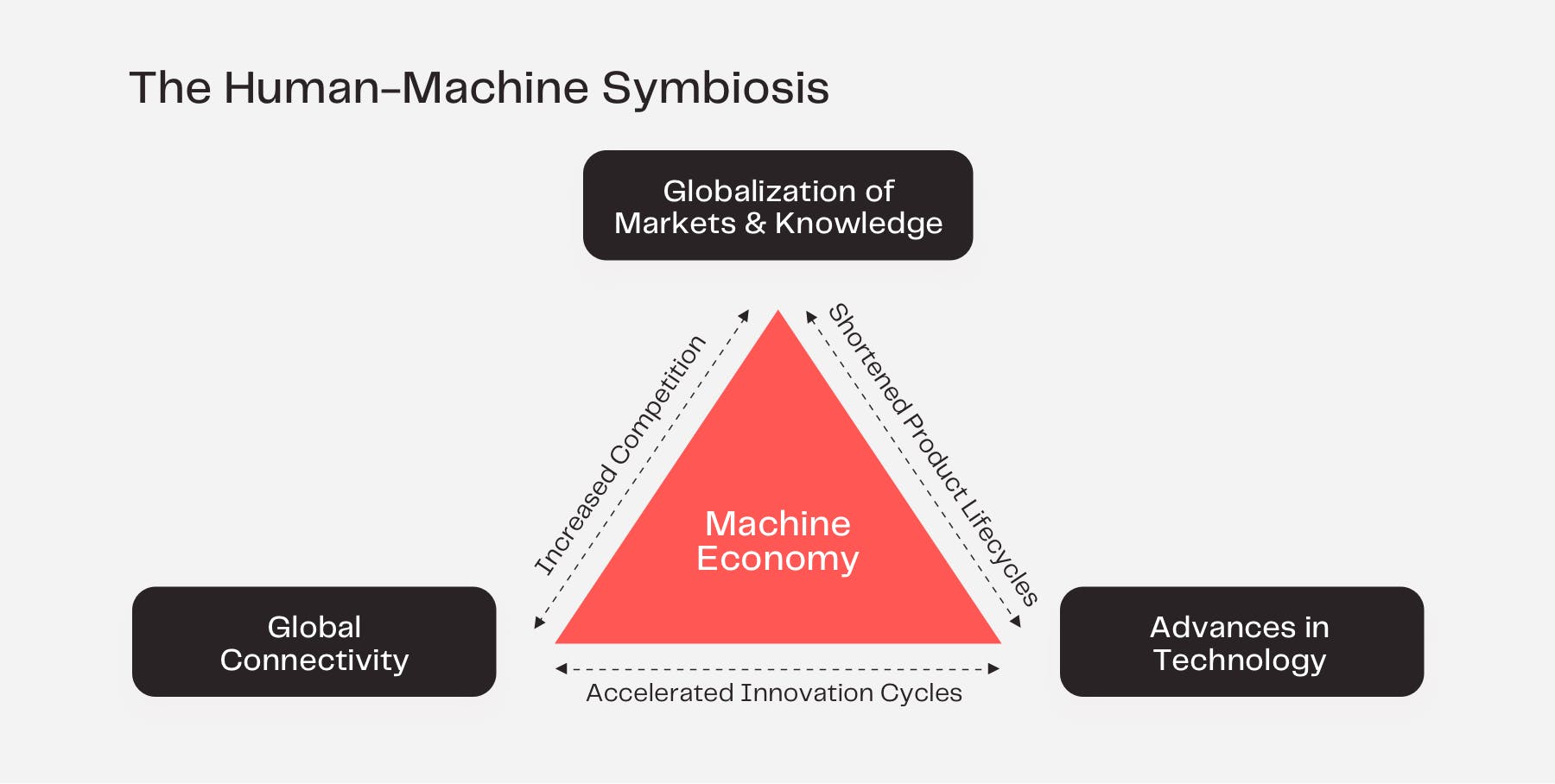
As businesses become increasingly connected worldwide, human and machine capabilities will become tied together with the Machine Economy at the center.
The Machine Economy puts technology solutions in place to generate more efficient systems and processes in the business. Combining machine learning technology with data insights can help businesses spot opportunities to improve its operations and secure additional profits. Thanks to machine learning technology, products are getting ‘smarter’ and businesses are adding layers of servitization to extend their value chain. These machines can be trained to recognize needs and anticipate the appropriate purchases or alerts at the right moment.
The Machine Economy is here, but it’s still in its early stages. The future of the Machine Economy raises many important questions for governments, companies, and society as a whole. It will require a global dialogue to shape a vision of automated production that promotes economic growth and innovation in an ethical, inclusive, and sustainable way. While technology impacts business and drives the Machine Economy forward, it’s ultimately business innovation that will shape the world of technology, giving it real purpose and practical applications. Now is the best time for savvy tech evangelists and business leaders to dive in and make their mark.




